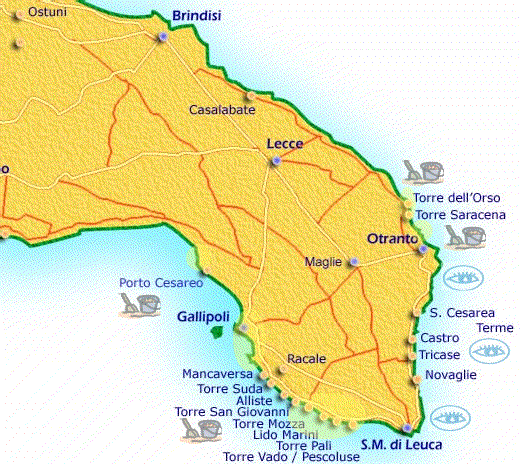Salento is located in the most south-eastern part of the Italian peninsula, the so-called “heel of the boot”, and more precisely it is located in the southernmost part of the Puglia region between the Brindisi coast, the Gulf of Taranto and the extreme southern tip (Leuca) also called “finibus terrae”.
Salento measures just under 6,000 square km and fully includes the province of Lecce and a small part of the provinces of Brindisi and Taranto, and is “embraced” by the Ionian Sea and the Adriatic Sea for more than 250 km, therefore it is located at the center of the Mediterranean Basin, exactly on the “border” between West and East, so much so that it is possible to witness both the sunrise from the eastern shore (Adriatic Sea) and the sunset from the western shore (Ionian Sea).
But what does Salento have more than other places in Italy? What is it that characterizes it? As said before, because of its particular geographical position, the “gateway to the East” has developed in recent centuries a particular “mix” between the cultures and traditions of the East and the West, as can be admired in the buildings, in the churches, in the fortified farms, characteristic of all the Salento municipalities, such as the Baroque which finds its largest and most beautiful structures in enchanting Lecce, all elements that tell a story that is certainly not recent but almost “lost in time” of all civilizations that lived and “influenced” this region of Italy until a few centuries ago.
Returning to the “natural” aspect of Salento, all its visitors will surely be impressed by the beautiful coasts: from the white sandy ones characterized by the so-called “dunes” to the high and vast cliffs rich in caves and ravines with seabed that have nothing to envy to those of other areas of Italy! We cannot fail to mention the splendid pine forests that precede the coasts of the Salento coasts, or, entering the hinterland, the extensive vineyards and olive groves characteristic of the Salento environment, such as the “holm oak” and the few, unfortunately few, specimens of “oak vallonea “present in the woods of Tricase or like the” Cesine “, one of the most important” wetlands of international value “(as declared by the Commission of Ramsar) where the wonders of Mediterranean flora and fauna can be admired.
Salento is a land where temperatures are very mild in winter and very hot in summer, and this is due, in addition to its geographical position, to a hot and humid wind that blows for many days of the year: the ” sirocco “. However, Salento being very flat is naturally affected by other winds as well as the sirocco heat such as the cold and dry “tramontana”. All this means that the average annual temperature is slightly below 20 ° C, with minimum peaks in January of around 10 ° C and maximum peaks in August with around 30 ° C, temperatures also facilitated by the countless sunny days prevailing during the year, alternating with irregular rains often frequent between November and April.
Salento is that strip of land that ends the heel of the Italian boot. It includes the province of Lecce and has a peninsular shape, being bathed by the splendid Ionian (West) and Adriatic (East) seas. A piece of land full of history and traditions, it makes natural and architectural beauties and hospitality its strengths to emerge more and more in the context of a tourism that too often takes for granted and dull forms.



